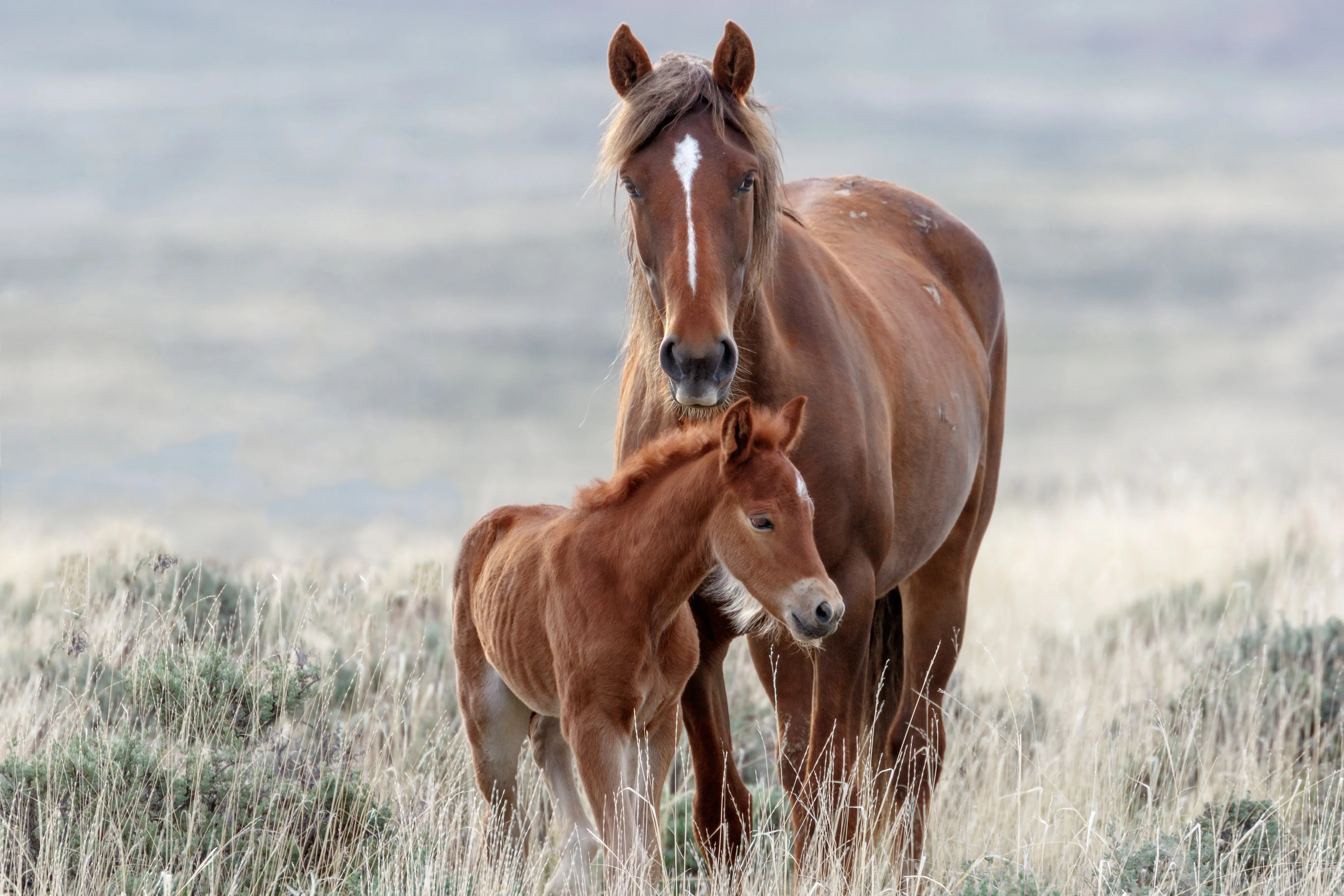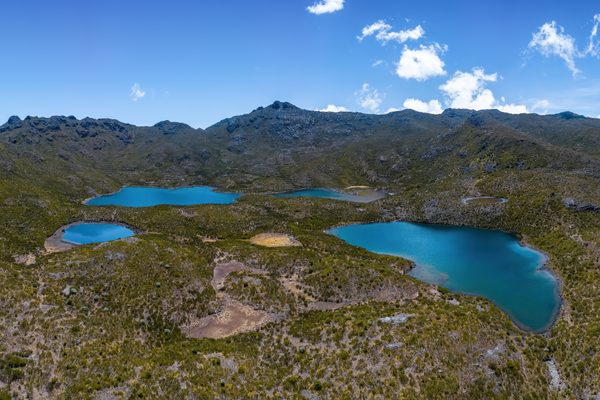American mustangs - a symbol of freedom
Besides being fascinating animals that symbolise freedom and convey a sense of adventure, mustangs are also a reminder of the exciting and turbulent history of the American continent. There are many cowboy and Native American myths about the wild four-legged friends. Even today, the mustang of the Wild West is still a current topic.
A horseless country before the 16th century
Horses were utterly unknown in America for a long time. The indigenous people, whether chief, hunter or warrior, walked for centuries. When the horse came, the lives of many tribes changed radically.

Fact sheet American Mustang
- Scientific name: Equus caballus
- Common name: American Mustang
- Order: Herbivora
- Characteristics: Highly crested necks, sloping shoulders with moderate muscle in their long-defined legs and straight backs.
- Size: 56 inches to 60 inches (140 to 150 cm) tall
- Weight: 800 pounds (363 kg)
- Life span: Up to 36 years
- Distribution: Nevada, California, Oregon, Utah, Montana, and Wyoming (Managed under Bureau of Land Management)
- Habitat: Grassland areas of the western U.S.
- Range: 10 to 100 square miles (region dependant)
- Diet: Grass and brush.
- Social Status: Herd (One stallion, eight females and young)
- Conservation status: Domesticated
Frequently asked questions about Mustangs
Are mustangs considered wild horses?
No, mustangs are not classic wild horses. They are a crossbreed of different European horse breeds. In the 16th century, they were introduced by the Spanish conquistadors. Some horses broke free, ran wild and developed a stable population.
In fact, behind the term mustang is not a wild horse in the classical sense, but rather a feral domestic horse breed. Today's mustangs originated in the 16th century, when the Spanish conquistadors colonised large parts of the American continent. On their ships were noble horses of Arabian or Andalusian blood. These 1,500 european, imported horses were the first horses to set their hooves on American soil. Escaped individuals from these domesticated horses quickly reproduced on the grassy prairie.
The wild runaways were called "mustangs", which comes from the Spanish word mestengo ( aspan. mesteño), which means "ownerless animal".
Where can you still find wild mustangs?
The habitat of mustangs in North America is barren and dry. Mustangs still live wild in some states of the USA - especially in Nevada, Montana, Oregon and Wyoming.
Why are mustangs captured?
Due to urbanisation, industry and road construction, mustangs have less and less land available. In addition, the BLM must strive to balance the interests of all users of the land and maintain its usability. This includes protection from overgrazing. Without control by capturing the overpopulation, winter starvation could be the consequence for many mustangs.
How much does a wild mustang cost?
Mustangs are not sold, but adopted. Private people who want to adopt a mustang pay the symbolic amount of 125 US dollars. The horse completes one year of adoption with a trainer.
If you want to buy a wild mustang from America in Europe, however, the price is quite different. The flight, the quarantine, examinations, official veterinary costs, papers, transport, tax, customs, etc. are expensive. Here, you have to calculate 6500 € for the purchase costs.
»Wild horses run unbridled or their spirit dies.«

Native American meets mustang: a life-changing encounter
It was not long before the Native Americans realised how valuable the "newcomers" were. Not only could they be eaten, but they could also be ridden, used as pack animals or exchanged for goods. Owning a horse had innumerable advantages. While on horseback, a hunter could chase his prey much longer and faster than on foot. Even the village communities now moved further into the prairie than ever before: They managed almost 20 kilometres a day on horseback - compared to only ten kilometres on foot with dogs as pack animals.
The Spanish colonists, however, refused to sell horses to the Native American. There-fore, Native Americans caught wild mustangs and tamed them or stole horses from the Spanish.
If you owned many horses, you were soon considered a rich man among the Native Americans. Those who could ride well earned respect. In the Native Americans tribes, a horse was a real treasure.
The end of the horse era
Time jump. We are in 1950. Secretary Velma B. Johnstons was about to leave for work when a truck with a trailer turned onto the road in front of her. Blood was dripping from the trailer. Deciding on the spur of the moment, the dedicated animal lover followed the vehicle.
When she arrived at a slaughterhouse, she learned that the passengers in the trailer were mustangs. It was clear to her that she had to do something about the cruel treatment of these impressive creatures. She was highly successful in doing so.
At that time, mustangs were captured in the most brutal way. The reason for the neck-breaking hunt by plane until the mustangs were exhausted was the high demand for horse meat for the animal feed industry.

Velma gained the attention and support of the public through letter-writing campaigns and achieved the first attainment of her goal. In 1959, a law was passed forbidding the hunting of mustangs with motorised vehicles and aircraft.
However, this law was not enough for the charismatic, strong-willed woman. She advocated for more extensive protection. As a result, the wild free-roaming horses and burros act of 1971 was passed, putting the mustangs under the protection of the government and ensuring that the mustangs and the public lands were managed by the BLM (Bureau of Land Management).
Perhaps, without this admirable woman, there would be no more mustangs today. Thankfully, wild mustangs still roam the west of the USA today.

The Mustang at today's time
Nowadays, mustangs fulfil important tasks in nature. In hot summers, they prevent the overgrowth of bushes, which is considered an essential part of fire protection. And in icy winters, they open frozen water holes with their hard hooves, which also benefits other animals.
However, if there are too many horses in a too small area, there is a risk that both the horses and the environment will suffer.
For this reason, the BLM tries to avoid overpopulation. This is why various mustang herds are trapped at regular intervals and some animals are given away for domestication. When mustangs were healthy and suitable for domestication, they were no longer allowed to be killed. Today, there is a general ban on the slaughter of mustangs in the USA.

The captured symbol of freedom
America's symbol of freedom is no longer that free. The captive population exceeds the number of wild animals. Since the 1973s, a horse adoption programme has been in operation to match appropriate horses with private people. Nevertheless, interest in wild horse adoption in the USA is so low that many captured mustangs remain in the BLM's care under inadequate conditions.
Source references:
Geolino.de
American-mustang.de
Live Science
Jicarilla Mustang Heritage Alliance
Healthline






